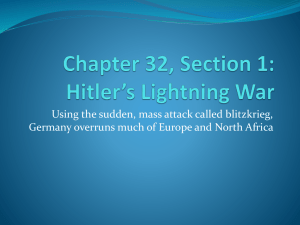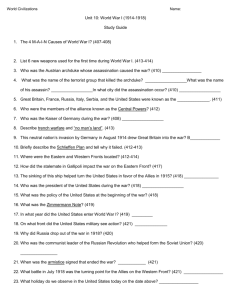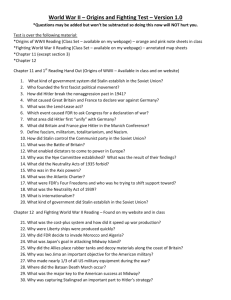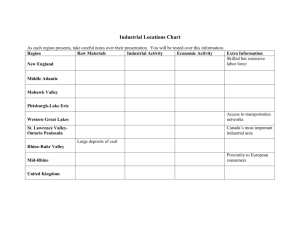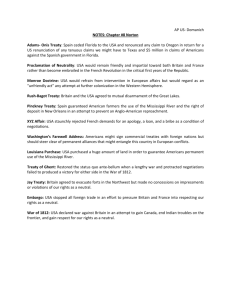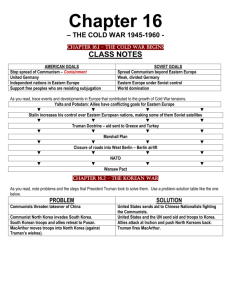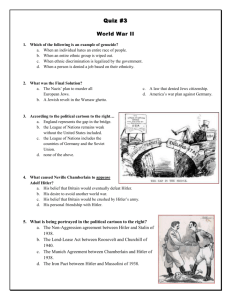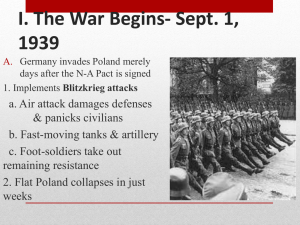Chapter 28 Outline – International Contacts and Conflicts, 1914
advertisement
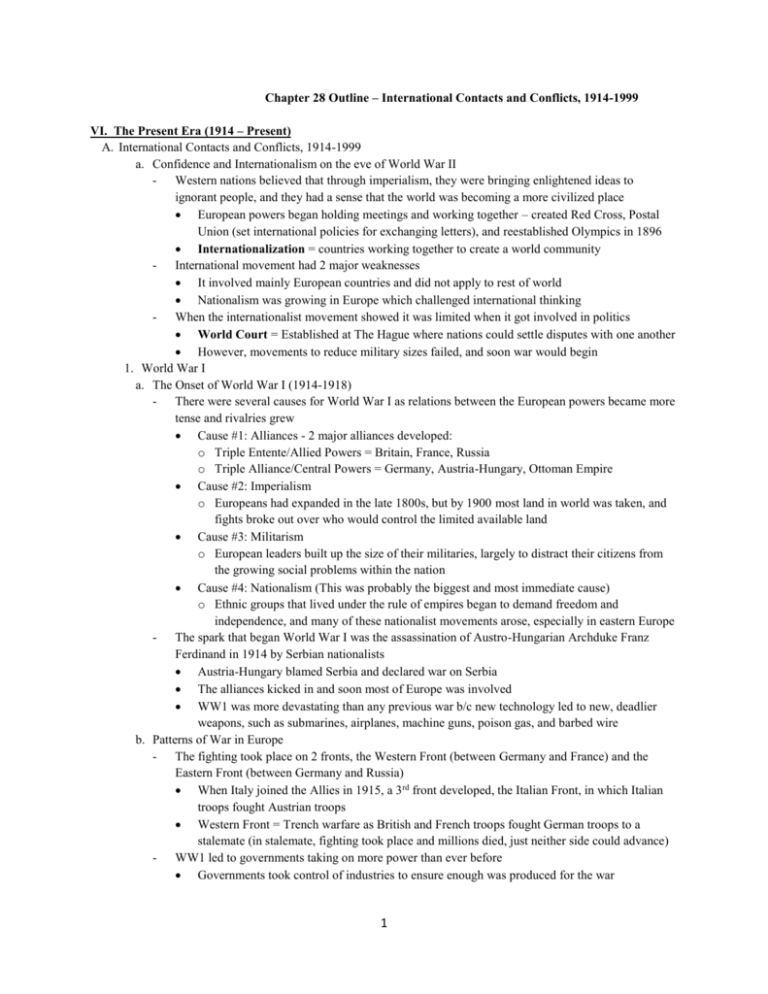
Chapter 28 Outline – International Contacts and Conflicts, 1914-1999 VI. The Present Era (1914 – Present) A. International Contacts and Conflicts, 1914-1999 a. Confidence and Internationalism on the eve of World War II - Western nations believed that through imperialism, they were bringing enlightened ideas to ignorant people, and they had a sense that the world was becoming a more civilized place European powers began holding meetings and working together – created Red Cross, Postal Union (set international policies for exchanging letters), and reestablished Olympics in 1896 Internationalization = countries working together to create a world community - International movement had 2 major weaknesses It involved mainly European countries and did not apply to rest of world Nationalism was growing in Europe which challenged international thinking - When the internationalist movement showed it was limited when it got involved in politics World Court = Established at The Hague where nations could settle disputes with one another However, movements to reduce military sizes failed, and soon war would begin 1. World War I a. The Onset of World War I (1914-1918) - There were several causes for World War I as relations between the European powers became more tense and rivalries grew Cause #1: Alliances - 2 major alliances developed: o Triple Entente/Allied Powers = Britain, France, Russia o Triple Alliance/Central Powers = Germany, Austria-Hungary, Ottoman Empire Cause #2: Imperialism o Europeans had expanded in the late 1800s, but by 1900 most land in world was taken, and fights broke out over who would control the limited available land Cause #3: Militarism o European leaders built up the size of their militaries, largely to distract their citizens from the growing social problems within the nation Cause #4: Nationalism (This was probably the biggest and most immediate cause) o Ethnic groups that lived under the rule of empires began to demand freedom and independence, and many of these nationalist movements arose, especially in eastern Europe - The spark that began World War I was the assassination of Austro-Hungarian Archduke Franz Ferdinand in 1914 by Serbian nationalists Austria-Hungary blamed Serbia and declared war on Serbia The alliances kicked in and soon most of Europe was involved WW1 was more devastating than any previous war b/c new technology led to new, deadlier weapons, such as submarines, airplanes, machine guns, poison gas, and barbed wire b. Patterns of War in Europe - The fighting took place on 2 fronts, the Western Front (between Germany and France) and the Eastern Front (between Germany and Russia) When Italy joined the Allies in 1915, a 3rd front developed, the Italian Front, in which Italian troops fought Austrian troops Western Front = Trench warfare as British and French troops fought German troops to a stalemate (in stalemate, fighting took place and millions died, just neither side could advance) - WW1 led to governments taking on more power than ever before Governments took control of industries to ensure enough was produced for the war 1 c. d. e. f. Executive branches took over from parliaments and people lost freedoms (ex: in most countries, criticism of the war was punished) - The use of spies became vital to both sides Mata Hari = one of most famous spies in history, she was a dancer in Paris who had love affairs with French army officers, and was soon accused of giving secrets she learned from them to the Germans; she was executed for being a spy by France The War Outside Europe - WW1 began in Europe, but fighting soon spread and people around the world got involved - The war helped the U.S. emerge as a major world power, both politically and militarily U.S. businesses profited greatly by selling war supplies to countries at war While U.S. was neutral at first, it joined the war on the Allies side in 1917 Submarine warfare = German u-boats (subs) would sink ships on the open seas, one of major reasons the U.S. entered the war against Germany U.S. entrance in war helped end the stalemate on the Western Front and the Allies soon won Combatants in Africa, Asia, and the Middle East - Fighting also took place in Germany’s colonies in Africa Many Africans fought in the war on the side of the country ruling them Since Allies were fighting to give ethnic groups in Eastern Europe their own independent nations, Africans believed victory in war would mean they would gain independence too - Fighting also occurred in east Asia Japan, who had previously signed peace treaty with G.B., joined on Allied side Even though China also sided with the Allies, Japan was able to gain Chinese land that had previously belonged to Germany, and so WW1 helped Japan to continue to build its empire Indians fought on side of British, thinking, like the Africans, that Allied victory would mean independence for India - World War I also had a huge impact on the Middle East Britain got Arabs to rebel against the Ottoman Empire, and the Arabs in turn were led to believe they would gain independence after the war Balfour Declaration (1917) = Britain promised to make a homeland in Middle East for Jews if they helped the British fight in the war The War’s End - In 1917, Russia experience a revolution and dropped out of World War I Treaty of Brest-Litovsk = Russia gave land to Germany in return for an end to fighting - As the Allies began advancing on Germany, there was a revolution in Germany, a new, democratic government took over, and Germany gave up in November of 1918 The Peace and the Aftermath - The Treaty of Versailles was signed after the war, but it led to more problems than it solved Leaders from the victorious nations were allowed to participate in writing treaty, and the treaty was very harsh on Germany (many Allies, especially France, were determined to get revenge) Germany was forced to give up territory (had to give Alsace and Lorraine back to France) Japan was mostly ignored, became angry, and continued aggressive, expansionist behavior U.S. President Woodrow Wilson promoted self-determination – people with similar ethnicities and cultures should be able to rule themselves if they desired (but he was not listened to) League of Nations = new international organization created to work out problems peacefully U.S. became isolationist following the war and didn’t join League of Nations Austria-Hungary was broken up and divided into several new nations (Czechoslovakia, Hungary, Yugoslavia, and Austria) 2 Germany forced to admit guilt for war and pay reparations to the Allies – this caused great economic hardship in Germany Since Russia dropped out of war, they were not allowed at peace conference and were left out of the League of Nations g. The War’s Devastations and Dislocations - World War I weakened Europe as a world power Over 10 million Europeans died, there was a sharp decline in birth rates (not many males to have babies), industries and farms were destroyed, and massive inflation set in after the war - Despite Allies support of nationalism (freedom and independence to different groups) European nations held onto most of their colonies after the war (only gave independence to Eastern Europe) Colonized people around world very upset, including leaders Gandhi (India) and Ho Chi Minh (Vietnam) - Major changes took place in the Middle East The Ottoman Empire, which ruled over the Middle East was broken up, and land in the Middle East was divided between Britain (Palestine and Iraq) and France (Syria and Lebanon) - Economic problems in Europe continued after the war U.S. and Japan had replaced Europe as leading exporter around the world 2. The Great Depression a. Causes of Economic Instability - Impact of WWI led to economic problems in Europe in the early 1920s Inflation, especially in Germany, meant life savings were worthless for many people Britain very slow to recover b/c depended on exporting goods, but had much more competition after the war (U.S., Japan, etc.) Farmers faced problems due to overproduction and declining prices, leading to further migration of people away from the countryside and to urban areas - Non-Western areas of the world were suffering greatly too Colonies were set up to export cash crops, but goods were being overproduced and prices went way down As result, colonies had less money to buy European exports, making Europe’s problem worse Governments turned to protectionism and high tariffs, further hurting trade and economies b. Collapse and Crisis - When U.S. stock market crashed in October of 1929, the Great Depression was under way Bank failures in U.S. soon spread to Europe, and most of Western world had no money/capital available for loans and investments Production fell off and factories went out of business c. Worldwide Impact - Some economies were not as badly affected by the Great Depression Socialism in one country = Soviet Union cut off economic ties with outside world to build a communist controlled economy - However, most of the rest of the world was hurt badly by the Great Depression Nations that produced food and raw materials saw their exports drop b/c Western nations were not buying from them anymore Japan, which relied on exports, was hit hard (ex: nobody bought luxury product like silk) Japanese became more suspect of the West, and continued to expand during this time In Latin America, the financial problem led to state intervention in economy In the West, new welfare programs (governments helping the poor) arose, but in some cases they led to extreme political movement (ex: Nazism in Germany) 3. World War II 3 a. New Authoritarian Regimes - A major cause of WW2 was the rise of totalitarian governments (total control) in Japan, Germany, and Italy which came to power after economic problems in the 1920s following WW1 Japan = military officers killed the prime minister and set up an ultranationalist, military regime, with an authoritarian government o Japan invaded Manchuria in 1931 in desire to have buffer zone against Russia o League of Nations did little to stop Japan Germany = Nationalist Socialist (Nazi) Party, led by Adolf Hitler came to power, (Hitler became chancellor in 1933) o Nazi goals included building up the military, expanding German territory, and ending the humiliation of the Versailles Treaty o Hitler expanded arms production, which produced new jobs and strengthened military Italy = Fascist government emerged in 1920s, led by Benito Mussolini o Mussolini promised aggressive foreign policy and nationalist glories o At 1st Mussolini moderate, but when Hitler emerged, Mussolini became more bold b. The Steps Toward War - Germany and Italy took actions in the 1930s led the world closer to war Germany violated Versailles Treaty – stopped paying reparations and built up military 1936 – Germany occupied the Rhineland (border between France and Germany) 1935 - Italy attacked Ethiopia Spanish Civil War (1936-1939) = Republican forces defeated by totalitarian forces (who were helped by Germany and Italy) and Spain became a dictatorship) Anschluss (1938) = Germany took control of Austria and united it with Germany 1938 – Germany invaded part of Czechoslovakia known as the Sudetenland - The League of Nations, specifically Britain and France, did not take strong action to stop Germany Appeasement = Policy of giving in to avoid a conflict (Europeans hoped to avoid another war) Munich Conference (1938) = Germany given part of Czechoslovakia (Sudetenland) in return for promise not to expand any further (represented height of appeasement) March 1939 – Germany took the rest of Czechoslovakia, violating Munich Pact Nazi-Soviet Pact (1939) = German peace treaty with Soviet Union, allowed Germany to attack Poland without fear of Soviets fighting back September 1, 1939 – Germany invaded Poland, Britain and France finally take action and declare war on Germany, and World War II began - War had already begun in Asia between Japan and China Japanese leaders were split on whether or not to fight China – some wanted to simply defend Manchuria and Korea, but those who wanted to invade China won out 1937 – Japan occupied Beijing and the Chinese fought back For next 8 years, Japan and China fought to a stalemate until war ended in 1945 Tripartite Pact (1940) = Japan allied with Germany and Italy (formed Axis Powers) c. The Course of the War: Japan’s Advance and Retreat - During the war, Japan focused on expanding in the Pacific, conquering much land (ex: French owned Indochina) As they continued to advance in Pacific, Japan would soon come into contact with U.S. possessions (Philippines, Hawaii), and Japan and U.S. tried, but failed to negotiate peace Pearl Harbor (Dec. 7, 1941) = Japan sneak attack against U.S., led to U.S. to enter WW2 Japan very successful early on, but U.S. turned the tide of war in middle of 1942, began advancing toward Japan, retook the Philippines in 1944, and began air assault of Japan itself 4 d. Germany Overreaches - Early on, Germany seemed invincible Blitzkrieg = German war strategy (“lightning warfare”) Germany quickly crushed Poland, Holland, Belgium, and France - While Germany was strong, the Allies were weak France defeated easily because of bad strategy (expected another trench war) Vichy Government = Government of France that was established by Germany after most of France had been conquered Battle of Britain = Britain next began air assault on Britain Winston Churchill = British prime minister and courageous leader that led the British through German assault without surrendering - By 1940, Germany controlled most of Europe and began taking British and French colonies in Africa - In 1941, THE BALANCE OF THE WAR BEGAN TO SHIFT After not getting Britain to surrender, Hitler turned attention to defeating Russia In June, 1941 Germany attacked Russia Soviets lost ground, but did not collapse When Germany couldn’t win quickly, winter set in and Germans unprepared for harsh conditions - Late 1941 also saw U.S. enter the war U.S. had already supported Britain with loans and equipment U.S. initially helped the British push back Germans in north Africa Battle of Stalingrad (1942) = Turning point as Soviet troops began driving Germans back - British and American troops began advancing up the Italian peninsula from north Africa, ousting Mussolini D-Day (June 6, 1944) = Allies invade France from across English Channel and drive back Germans Allied forces gradually moved toward Germany and began massive bombing campaign In April, 1945, Russian and American troops met on Elbe River and had conquered Germany April 30, 1945 – Hitler committed suicide in his bunker, and in May, Germany formally surrendered - The war in Pacific ended a few months later Hiroshima and Nagasaki = Japanese cities that Americans dropped atomic bombs on, leading to Japanese surrender, ending WW2 e. Human Costs - WW2 caused extreme devastation, and a total of 35 million people were killed Japanese treated their captives extremely cruelly (ex: “Rape of Nanking” = Japanese killed over 300,000 Chinese after taking the city) Holocaust = systematic killing of Jews by Hitler, 6 million Jews killed Allies firebombed Germany and Japan (ex: German city of Dresden totally destroyed) Harry Truman = American president who ordered atomic bombing of Japan which resulted in massive casualties f. The Settlement of World War II - United Nations = International organization formed after WW2 to maintain peace More effective than League of Nations – many more countries were involved Security Council = Important part of U.N., it consists of the 5 nations that wield the most power in the United Nations – U.S., Great Britain, Russia, France, and China 5 U.N. goes beyond negotiating peace, also has agencies to help address social problems (ex: child labor, women’s rights, environmental issues) - The Allies (U.S., G.B., and U.S.S.R.) met several times during and after the war to discuss policies Teheran Conference (1943) = Meeting of F.D.R. (U.S.), Churchill (G.B.), and Stalin (U.S.S.R.) in which Stalin pushed for the Americans and British to open a second front against Germany in France (eventually happens with the D-Day invasion in 1944) Yalta Conference (Feb., 1945) = F.D.R., Churchill, and Stalin met as war was winding down to discuss postwar plans, which included agreement to divide Germany into 4 zones; but they disagreed on Eastern Europe (Soviets wanted to maintain control for protection) Potsdam Conference (July, 1945) = Truman (U.S.), Churchill, and Stalin met to discuss situation in Eastern Europe; Soviets troops were occupying Eastern European countries, and the U.S.S.R. would maintain great influence over them for the next 45 years - These meetings also addressed postwar plans for the rest of the world U.S. would occupy Japan, and Korea was taken away from them – North Korea fell under Soviet control and became communist, and South Korea allied with the U.S. In Asia, former colonies were given back to their prewar “owners”, not given independence yet China regained land it lost to Japan, but had deep division that led to a civil war Middle East, India, and Africa were also returned to prewar “owners” 4. The Cold War and Decolonization, 1945-1989 - Cold War (1945-1991) = International conflict between U.S. and Soviet Union in which the two sides never fought directly, but the conflict affecting the entire world Iron Curtain = Term used by Winston Churchill to describe the division b/t Western Europe (democratic) and Eastern Europe (communist) - In order to prevent communism from spreading outside eastern Europe, the U.S. took action Truman Doctrine (1947) = U.S. gave weapons to Greece and Turkey to avoid communist takeovers Marshall Plan (1947) = U.S. gave billions of dollars to western European nations so they could rebuild after WW2l designed to prevent western Europe from turning to communism - Germany was the initial focal point of the Cold War Germany had been divided into 4 zones, and the Americans, British, and French united their zones in the western part of Germany and focused on economic rebuilding of Germany The Soviet instead focused on gaining war reparations and supplies from their German zone Berlin Blockade (1947-1948) = Soviets cut off West Germany from city of Berlin, the now divided former capital which was located in the Soviet zone Berlin Airlift = U.S. responded with massive airlift and blockade was called off; Germany remained officially divided into two new nations: West Germany and East Germany - There were two major alliances during the Cold War North Atlantic Treaty Organization (NATO) (formed 1949) = Alliance b/t U.S., Canada, and western European nations which promoted democracy and capitalism Warsaw Pact = Soviet alliance with eastern European nations (known as satellite nations) formed in response to NATO Soviets developed the atomic bomb in 1949, beginning an arms race that would see both the U.S. and Soviet Union build up massive arsenals of nuclear as well as conventional weapons - Cold War greatly affected areas outside of Europe Korean War (1950-1953) = U.S. successfully fought to defend South Korea after it was invaded by communist North Korea Cuban Missile Crisis (1962) = Closest U.S. and U.S.S.R. came to nuclear war 6 Vietnam War (1954-1973) = U.S. failed to stop the spread of communism in Vietnam By the 1970s, tensions in the Cold War began to ease some Arms limitation treaties were signed b/t U.S. and Soviets - While the Cold War was going on, the process of decolonization was occurring (most colonies in world gained freedom) and the two movements became intertwined The new nations in Asia and Africa often got involved in Cold War on one side or the other, though many were able to avoid taking sides (called non-alignment), with India as example - During the Cold War, countries of the world were become more closely connected Economic interactions b/t nations grew, and many multinational corporations were formed Multinational corporations generally started in West and moved to other areas of the world, vastly affecting the new regions they moved to (sometimes positively, but sometimes negatively, such as workers being exploited and pollution problems) Oil shortages (1973, 1979) showed how economy was becoming global b/c they affected so many nations around the world - The Cold War began to end in the 1980s The U.S., under President Ronald Reagan, greatly increased spending on military and Soviets could not keep up b/c they were having major economic difficulties Soviet leader Mikhail Gorbachev began negotiating w/ U.S. (arms reduction treaties, giving freedoms to eastern Europe) and in 1991, the Soviet Union was ended and Cold War was over a. Period III: The 1990s and Beyond - The end of Cold War represented new period in world history still going on today in which: U.S. is only superpower and has no military rival like it did during Cold War Regional tensions have emerged: Pakistan v. India, fighting in former Yugoslavia, mass killings in Africa There has been an increase in regional trade: European Union, NAFTA Nations around the world have moved away from state controlled industry to private enterprise - 7
